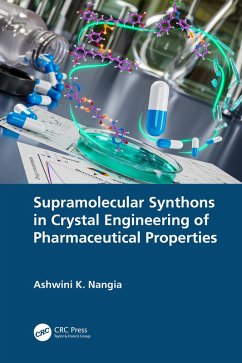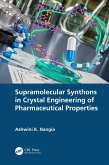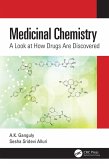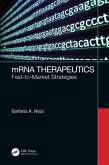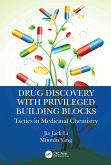Supramolecular Synthons in Crystal Engineering of Pharmaceutical Properties (eBook, ePUB)


Alle Infos zum eBook verschenken

Supramolecular Synthons in Crystal Engineering of Pharmaceutical Properties (eBook, ePUB)
- Format: ePub
- Merkliste
- Auf die Merkliste
- Bewerten Bewerten
- Teilen
- Produkt teilen
- Produkterinnerung
- Produkterinnerung

Hier können Sie sich einloggen

Bitte loggen Sie sich zunächst in Ihr Kundenkonto ein oder registrieren Sie sich bei bücher.de, um das eBook-Abo tolino select nutzen zu können.
This comprehensive resource skillfully consolidates crystal engineering, the design of organic solids, and supramolecular synthons (i.e., structural hydrogen bond units) to achieve desired pharmaceutical properties, including solubility, dissolution, bioavailability, permeability, particle size, tableting, hydration, and mechanical strength. Covering 30 years of crystal engineering developments and pharmaceutical applications, this book will be a single and complete resource for supramolecular and structural chemists, the crystal engineering community, pharmaceutical scientists, and industrial…mehr
- Geräte: eReader
- mit Kopierschutz
- eBook Hilfe
![Supramolecular Synthons in Crystal Engineering of Pharmaceutical Properties (eBook, PDF) Supramolecular Synthons in Crystal Engineering of Pharmaceutical Properties (eBook, PDF)]() Ashwini K. NangiaSupramolecular Synthons in Crystal Engineering of Pharmaceutical Properties (eBook, PDF)180,95 €
Ashwini K. NangiaSupramolecular Synthons in Crystal Engineering of Pharmaceutical Properties (eBook, PDF)180,95 €![Medicinal Chemistry (eBook, ePUB) Medicinal Chemistry (eBook, ePUB)]() A. K. GangulyMedicinal Chemistry (eBook, ePUB)55,95 €
A. K. GangulyMedicinal Chemistry (eBook, ePUB)55,95 €![Medicinal Plants in the Asia Pacific for Zoonotic Pandemics, Volume 3 (eBook, ePUB) Medicinal Plants in the Asia Pacific for Zoonotic Pandemics, Volume 3 (eBook, ePUB)]() Christophe WiartMedicinal Plants in the Asia Pacific for Zoonotic Pandemics, Volume 3 (eBook, ePUB)107,95 €
Christophe WiartMedicinal Plants in the Asia Pacific for Zoonotic Pandemics, Volume 3 (eBook, ePUB)107,95 €![Biological and Pharmacological Properties of the Genus Moringa (eBook, ePUB) Biological and Pharmacological Properties of the Genus Moringa (eBook, ePUB)]() Biological and Pharmacological Properties of the Genus Moringa (eBook, ePUB)45,95 €
Biological and Pharmacological Properties of the Genus Moringa (eBook, ePUB)45,95 €![mRNA Therapeutics (eBook, ePUB) mRNA Therapeutics (eBook, ePUB)]() Sarfaraz K. NiazimRNA Therapeutics (eBook, ePUB)46,95 €
Sarfaraz K. NiazimRNA Therapeutics (eBook, ePUB)46,95 €![Drug Discovery with Privileged Building Blocks (eBook, ePUB) Drug Discovery with Privileged Building Blocks (eBook, ePUB)]() Jie Jack LiDrug Discovery with Privileged Building Blocks (eBook, ePUB)78,95 €
Jie Jack LiDrug Discovery with Privileged Building Blocks (eBook, ePUB)78,95 €![Medicinal Plants in the Asia Pacific for Zoonotic Pandemics, Volume 2 (eBook, ePUB) Medicinal Plants in the Asia Pacific for Zoonotic Pandemics, Volume 2 (eBook, ePUB)]() Christophe WiartMedicinal Plants in the Asia Pacific for Zoonotic Pandemics, Volume 2 (eBook, ePUB)107,95 €
Christophe WiartMedicinal Plants in the Asia Pacific for Zoonotic Pandemics, Volume 2 (eBook, ePUB)107,95 €-
-
-
Key Features
- Covers the fundamentals of crystal engineering and supramolecular synthons.
- Details the challenges of low solubility and low permeability facing oral drug formulations.
- Explains how heterosynthons provide a rational approach to address and implement solutions.
- Provides case studies from academic and industrial labs to walk the reader through the actual steps.
- Explores developments in the scale up and manufacture of crystal forms in pharmaceutical industry.
Dieser Download kann aus rechtlichen Gründen nur mit Rechnungsadresse in A, B, BG, CY, CZ, D, DK, EW, E, FIN, F, GR, HR, H, IRL, I, LT, L, LR, M, NL, PL, P, R, S, SLO, SK ausgeliefert werden.
- Produktdetails
- Verlag: Taylor & Francis eBooks
- Seitenzahl: 198
- Erscheinungstermin: 1. Oktober 2024
- Englisch
- ISBN-13: 9781040124697
- Artikelnr.: 72270030
- Verlag: Taylor & Francis eBooks
- Seitenzahl: 198
- Erscheinungstermin: 1. Oktober 2024
- Englisch
- ISBN-13: 9781040124697
- Artikelnr.: 72270030
- Herstellerkennzeichnung Die Herstellerinformationen sind derzeit nicht verfügbar.
pKa rule 2.4.3 Computational methods 2.4.4 Molecular electrostatic potential surface energy 2.4.5 Hansen solubility parameter 2.5 Summary conclusions 2.6 References 2.7 Questions and thoughts Chapter 3 Pharmaceutical Solid-State Forms 3.1 Introduction 3.2 Pharmaceutical multi-component crystals 3.2.1 Drug salts and pharmaceutical cocrystals 3.2.2 Pharmaceutical cocrystals via crystal engineering 3.2.3 Coamorphous solids 3.2.4 Solid solutions and eutectics 3.2.5 Ionic liquids 3.2.6 Ionic cocrystals 3.2.7 Nanocrystalline drugs 3.2.8 Supramolecular gels of drugs 3.2.9 Salt
cocrystal continuum or hybrid quasi-state of proton 3.2.10 Cocrystal polymorphs 3.2.11 Ternary and higher organic cocrystals 3.3 Summary conclusions 3.4 References 3.5 Questions and thoughts Chapter 4 Design and Methodology of Pharmaceutical Cocrystals 4.1 Introduction 4.2 Complementarity between API and coformer 4.3 Preparation methods of cocrystals 4.3.1 Spray drying 4.3.2 Freeze drying 4.3.3 Hot melt extrusion 4.3.4 Rotary evaporator method 4.3.5 Vapor-assisted tumbling 4.4 Drug
drug cocrystals 4.5 Drug
nutraceutical cocrystals 4.6 Ternary and higher order cocrystals 4.7 Cocrystals of different stoichiometry 4.8 Zwitterionic cocrystals 4.9 Halogen-bonded pharmaceutical cocrystals 4.10 Characterization methods of cocrystals 4.11 Summary conclusions 4.12 References 4.13 Questions and thoughts Chapter 5 Applications of Pharmaceutical Cocrystals 5.1 Introduction 5.2 Bioavailability improvement 5.3 Hydration stability 5.4 Chemical degradation stability 5.5 Tableting 5.6 Mechanical properties 5.7 Phase diagram and solubility measurements 5.8 Permeability and plasma concentration 5.9 Spring and Parachute model 5.10 Summary conclusions 5.11 References 5.12 Questions and thoughts Chapter 6 Continuous Manufacturing of Cocrystals and Salts 6.1 Introduction 6.2 Batch and flow chemistry 6.3 Flow chemistry and pharmaceutical cocrystals manufacturing 6.4 Case studies of pharmaceutical cocrystals and salts 6.5 Continuous process technologies 6.6 Flow guide for the synthetic chemist 6.7 Summary conclusions 6.8 References 6.9 Questions and thoughts Chapter 7 Commercial Outlook of Pharmaceutical Cocrystals 7.1 Introduction 7.2 Present status 7.3 Patenting and regulatory aspects 7.4 Entresto® drug-drug cocrystal salt 7.5 Seglentis® US-FDA approval 7.6 Summary conclusions 7.7 References 7.8 Questions and thoughts Chapter 8 Controlling Polymorphism 8.1 Introduction 8.2 Definition and importance 8.3 Polymorphism and cocrystallization 8.4 Tailored additives to control crystal size and morphology 8.5 Summary conclusions 8.6 References 8.7 Questions and thoughts Chapter 9 Supramolecular Heterosynthon in High Bioavailability Drugs 9.1 Introduction 9.2 Common heterosynthons in drugs 9.3 Heterosynthon model for high bioavailability drugs 9.4 Models for permeability enhancement 9.5 Cocrystal drugs beyond the Rule of 5 9.6 Improving cell penetration by atom replacement 9.7 Summary conclusions 9.9 Questions and thoughts Chapter 10 Other Applications of Cocrystals 10.1 Introduction 10.2 Property engineering 10.3 Mechanochemistry 10.4 Energetic cocrystals 10.5 Summary conclusions 10.6 References 10.7 Questions and thoughts Chapter 11 AI ML ChatGPT in Chemistry 11.1 Introduction 11.2 Retrosynthetic reaction prediction 11.3 Medicinal molecules 11.4 MOFs and inorganic materials 11.5 Cocrystals 11.6 Summary conclusions 11.7 References 11.8 Questions and thoughts Chapter 12 3D Electron Diffraction 12.1 Introduction 12.2 Advantages of ED 12.3 Resurgence of ED 12.4 New pharmaceutical challenges solved by ED 12.5 Summary conclusions 12.6 References 12.7 Questions and thoughts Chapter 13 Challenges, Conclusions, and Future Directions 13.1 Introduction 13.2 Carboxamide
pyridine-N-oxide heterosynthon 13.3 Browsing the literature 13.4 Challenges in pharmaceutical cocrystal technology 13.5 Conclusions 13.6 References 13.7 Suggested reading Index
pKa rule 2.4.3 Computational methods 2.4.4 Molecular electrostatic potential surface energy 2.4.5 Hansen solubility parameter 2.5 Summary conclusions 2.6 References 2.7 Questions and thoughts Chapter 3 Pharmaceutical Solid-State Forms 3.1 Introduction 3.2 Pharmaceutical multi-component crystals 3.2.1 Drug salts and pharmaceutical cocrystals 3.2.2 Pharmaceutical cocrystals via crystal engineering 3.2.3 Coamorphous solids 3.2.4 Solid solutions and eutectics 3.2.5 Ionic liquids 3.2.6 Ionic cocrystals 3.2.7 Nanocrystalline drugs 3.2.8 Supramolecular gels of drugs 3.2.9 Salt
cocrystal continuum or hybrid quasi-state of proton 3.2.10 Cocrystal polymorphs 3.2.11 Ternary and higher organic cocrystals 3.3 Summary conclusions 3.4 References 3.5 Questions and thoughts Chapter 4 Design and Methodology of Pharmaceutical Cocrystals 4.1 Introduction 4.2 Complementarity between API and coformer 4.3 Preparation methods of cocrystals 4.3.1 Spray drying 4.3.2 Freeze drying 4.3.3 Hot melt extrusion 4.3.4 Rotary evaporator method 4.3.5 Vapor-assisted tumbling 4.4 Drug
drug cocrystals 4.5 Drug
nutraceutical cocrystals 4.6 Ternary and higher order cocrystals 4.7 Cocrystals of different stoichiometry 4.8 Zwitterionic cocrystals 4.9 Halogen-bonded pharmaceutical cocrystals 4.10 Characterization methods of cocrystals 4.11 Summary conclusions 4.12 References 4.13 Questions and thoughts Chapter 5 Applications of Pharmaceutical Cocrystals 5.1 Introduction 5.2 Bioavailability improvement 5.3 Hydration stability 5.4 Chemical degradation stability 5.5 Tableting 5.6 Mechanical properties 5.7 Phase diagram and solubility measurements 5.8 Permeability and plasma concentration 5.9 Spring and Parachute model 5.10 Summary conclusions 5.11 References 5.12 Questions and thoughts Chapter 6 Continuous Manufacturing of Cocrystals and Salts 6.1 Introduction 6.2 Batch and flow chemistry 6.3 Flow chemistry and pharmaceutical cocrystals manufacturing 6.4 Case studies of pharmaceutical cocrystals and salts 6.5 Continuous process technologies 6.6 Flow guide for the synthetic chemist 6.7 Summary conclusions 6.8 References 6.9 Questions and thoughts Chapter 7 Commercial Outlook of Pharmaceutical Cocrystals 7.1 Introduction 7.2 Present status 7.3 Patenting and regulatory aspects 7.4 Entresto® drug-drug cocrystal salt 7.5 Seglentis® US-FDA approval 7.6 Summary conclusions 7.7 References 7.8 Questions and thoughts Chapter 8 Controlling Polymorphism 8.1 Introduction 8.2 Definition and importance 8.3 Polymorphism and cocrystallization 8.4 Tailored additives to control crystal size and morphology 8.5 Summary conclusions 8.6 References 8.7 Questions and thoughts Chapter 9 Supramolecular Heterosynthon in High Bioavailability Drugs 9.1 Introduction 9.2 Common heterosynthons in drugs 9.3 Heterosynthon model for high bioavailability drugs 9.4 Models for permeability enhancement 9.5 Cocrystal drugs beyond the Rule of 5 9.6 Improving cell penetration by atom replacement 9.7 Summary conclusions 9.9 Questions and thoughts Chapter 10 Other Applications of Cocrystals 10.1 Introduction 10.2 Property engineering 10.3 Mechanochemistry 10.4 Energetic cocrystals 10.5 Summary conclusions 10.6 References 10.7 Questions and thoughts Chapter 11 AI ML ChatGPT in Chemistry 11.1 Introduction 11.2 Retrosynthetic reaction prediction 11.3 Medicinal molecules 11.4 MOFs and inorganic materials 11.5 Cocrystals 11.6 Summary conclusions 11.7 References 11.8 Questions and thoughts Chapter 12 3D Electron Diffraction 12.1 Introduction 12.2 Advantages of ED 12.3 Resurgence of ED 12.4 New pharmaceutical challenges solved by ED 12.5 Summary conclusions 12.6 References 12.7 Questions and thoughts Chapter 13 Challenges, Conclusions, and Future Directions 13.1 Introduction 13.2 Carboxamide
pyridine-N-oxide heterosynthon 13.3 Browsing the literature 13.4 Challenges in pharmaceutical cocrystal technology 13.5 Conclusions 13.6 References 13.7 Suggested reading Index
